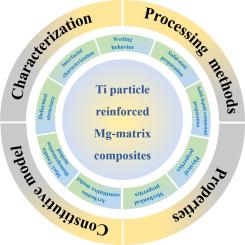可变形钛增强镁基复合材料的潜力:制备、表征和性能评价综述
IF 13.8
1区 材料科学
Q1 METALLURGY & METALLURGICAL ENGINEERING
引用次数: 0
摘要
镁基复合材料(MMCs)结合了低密度、高比强度和刚度,使其成为航空航天、汽车和电子工业的关键材料。本文综述了近年来Ti-Mg复合材料的制备进展,并分析了其增强力学性能的机理。一个关键的焦点是Ti和Mg相之间的界面变形不相容,它产生应变梯度并促进界面上几何上必要的位错(GNDs)的积累。这一过程不仅提高了应变硬化和延展性,而且表明需要先进的微观力学模型来捕捉这两相的塑性行为。该综述严格检查了不同Mg基体类型(AZ, AM, VW系列)的影响以及界面产物形态和尺寸对键合和整体性能的作用。此外,Ti增强使复合材料具有优异的耐磨性和导热性,具有广阔的应用前景。本文章由计算机程序翻译,如有差异,请以英文原文为准。


The potential of deformable titanium reinforced magnesium‐matrix composites: A review of preparation, characterization, and performance evaluation
Magnesium matrix composites (MMCs) combine exceptional low density, high specific strength, and stiffness, positioning them as critical materials for aerospace, automotive, and electronics industries. This review highlights recent progress in the fabrication of Ti-Mg composites and analyzes the mechanisms behind their enhanced mechanical properties. A key focus is the interfacial deformation incompatibility between Ti and Mg phases, which generates strain gradients and promotes the accumulation of geometrically necessary dislocations (GNDs) at the interface. This process not only improves strain hardening and ductility but also reveals the need for advanced micromechanical models to capture the plastic behavior of both phases. The review critically examines the impact of different Mg matrix types (AZ, AM, VW series) and the role of interfacial product morphology and size on bonding and overall performance. Furthermore, Ti reinforcement endows the composites with superior wear resistance and thermal conductivity, indicating broad application potential.
求助全文
通过发布文献求助,成功后即可免费获取论文全文。
去求助
来源期刊

Journal of Magnesium and Alloys
Engineering-Mechanics of Materials
CiteScore
20.20
自引率
14.80%
发文量
52
审稿时长
59 days
期刊介绍:
The Journal of Magnesium and Alloys serves as a global platform for both theoretical and experimental studies in magnesium science and engineering. It welcomes submissions investigating various scientific and engineering factors impacting the metallurgy, processing, microstructure, properties, and applications of magnesium and alloys. The journal covers all aspects of magnesium and alloy research, including raw materials, alloy casting, extrusion and deformation, corrosion and surface treatment, joining and machining, simulation and modeling, microstructure evolution and mechanical properties, new alloy development, magnesium-based composites, bio-materials and energy materials, applications, and recycling.
 求助内容:
求助内容: 应助结果提醒方式:
应助结果提醒方式:


